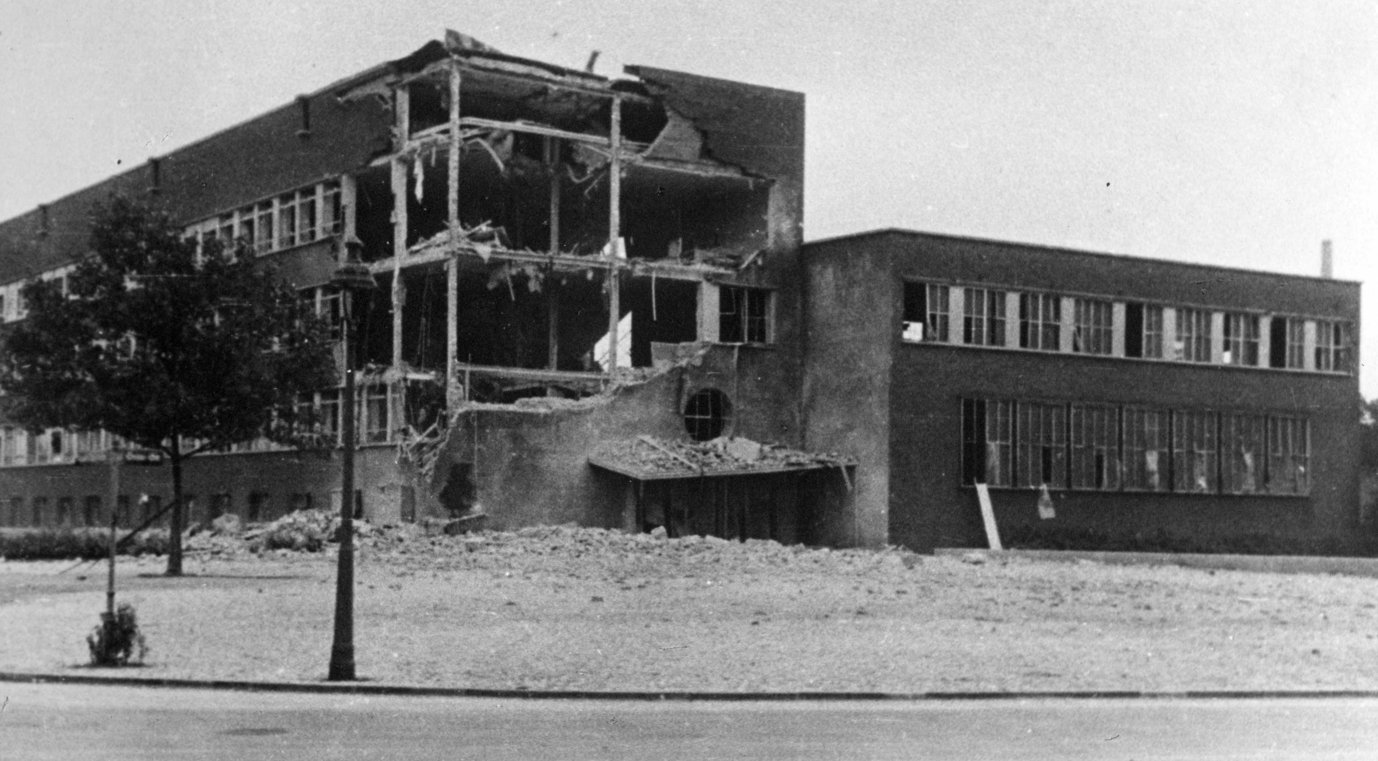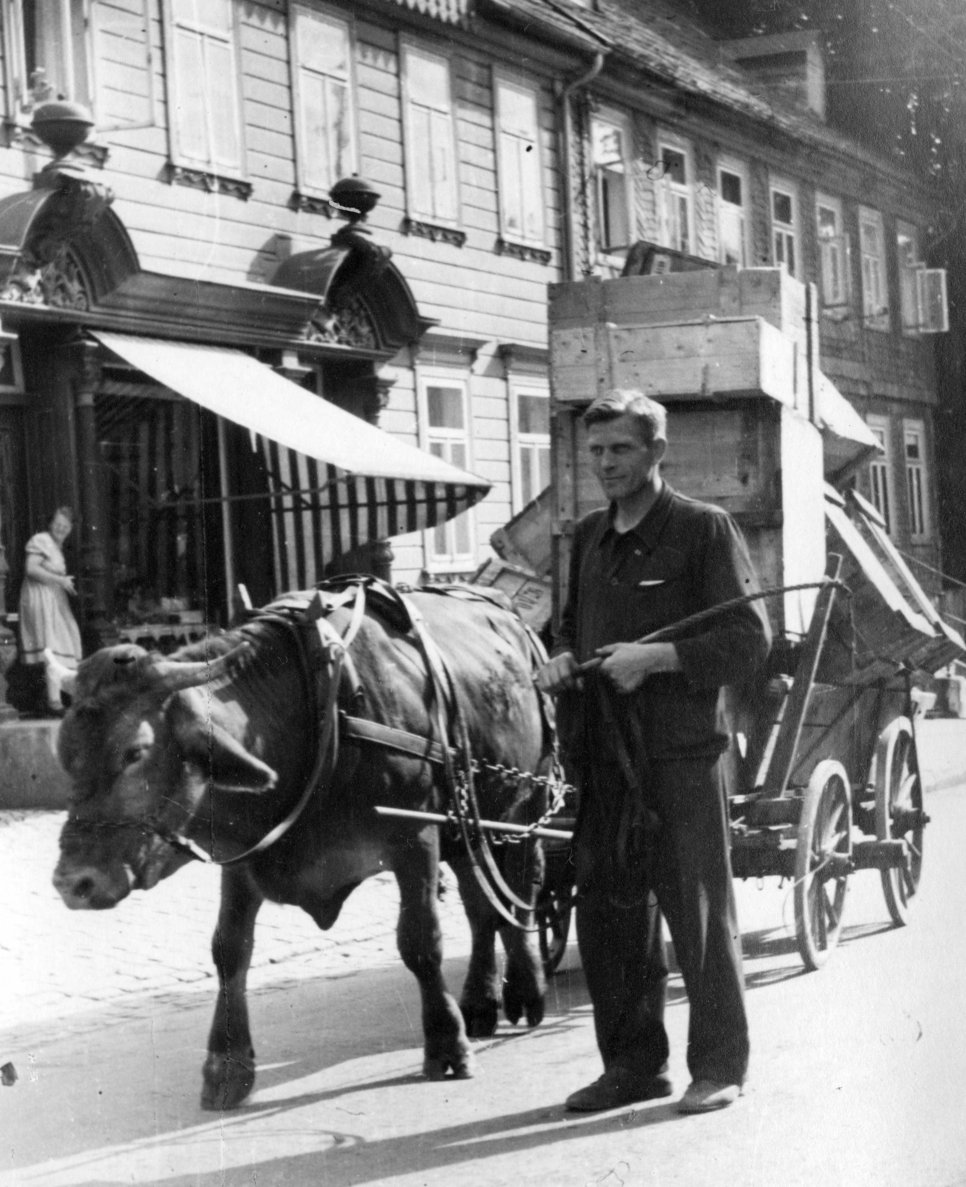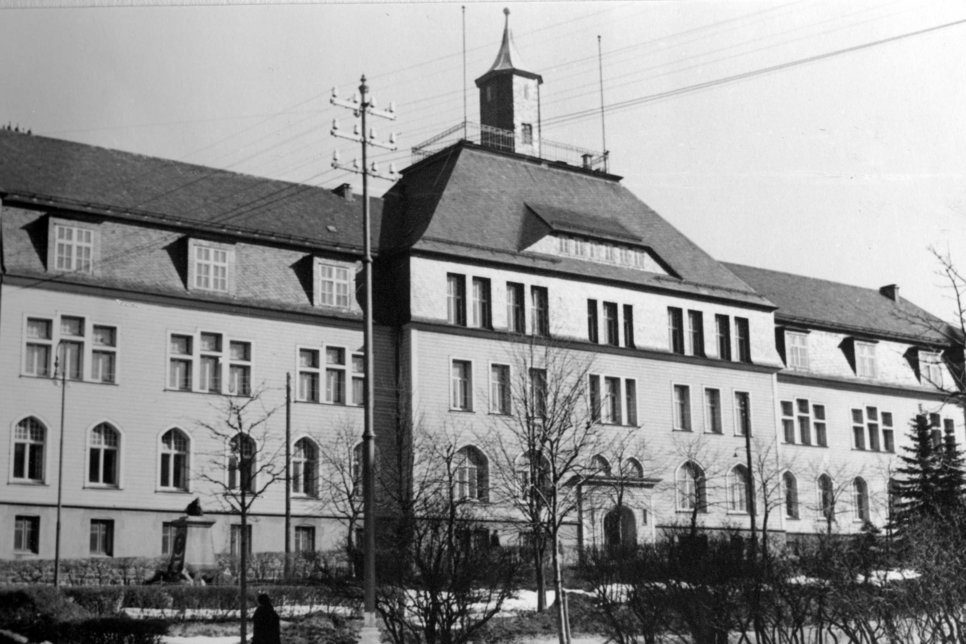06: After 1943: Bomb Damage, Evacuation to Clausthal and End of War
In the summer of 1943, the Kaiser-Wilhelm-Institut für Eisenforschung (KWIE) was badly hit during two severe air raids of the Allied Forces on Düsseldorf.
On the night of 11th June 1943, both the civil servants' living quarters and the magnet research laboratory were completely destroyed by the bomb attacks while the remaining buildings suffered considerable damage. A few weeks later the front of the main building was hit by another bomb on 22nd August 1943.[1]

Due to this severe damage, the major part of the institute was moved to the mining college at Clausthal in the Harz region. About a quarter of the workforce had to remain in Düsseldorf and start the reconstruction work. By the summer of 1944 work at Clausthal resumed provisionally with the laboratory for ore dressing, the technological laboratory, the major part of the metallurgical laboratory and parts of the strength test laboratory staying in Düsseldorf. However, the division of the institute meant that effective work was impossible.[2]

In July 1944 the director of the institute, Friedrich Körber, died. His position was now taken over by Franz Wever, physicist and materials science engineer. He was also a wing commander at the Luftwaffe, SA "Sturmführer", and a member of the Nazi party and was promoted to his position following a positive assessment by the Sicherheitsdienst (security service) of the Reichsführer SS.[3] After another severe bomb attack on 3rd November 1944 in which the institute suffered several direct hits and the electricity centre was completely destroyed, Wever decided to evacuate the remaining departments to Clausthal, too.[4] Not only German workers were employed for the evacuation of the institute but also forced labourers from Eastern Europe who unloaded the railway waggons. There are some indications suggesting that forced labourers had worked for the KWIE before that. However, precise figures or further details about the type of employment are not known. There is a reference in one work report for 1943 which the KWIE prepared for the ministry of science in April 1944 stating that nine further foreign workers had been employed during the reporting period. One must therefore assume that a larger number of foreigners was involved.[5]

Clausthal was taken by American troops on 12th and 13th April 1945. Shortly after that records and equipment of the KWIE were confiscated and the institute was classified as "principal target" by the Allies because of its prominent position among metallurgical research institutions in Germany.[6] The staff was therefore questioned in detail and the institute was banned from working. The director, Franz Wever, was interned because of his entanglement with the Nazi regime. Albert Vögler, the president of the Kaiser-Wilhelm-Gesellschaft (KWG) and chairman of the KWIE board of trustees, eluded arrest by committing suicide on 14th April 1945.[7]
Read how the story continues...
[1] cf. Max-Planck-Institut für Eisenforschung: 10 Jahre Eisenforschung 1945-1954, Düsseldorf, 1955, p. 5 and Flachowsky, Sören: Von der Wagenburg der Autarkie zu transnationaler Zusammenarbeit. Der Verein Deutscher Eisenhüttenleute und das KWI/MPI für Eisenforschung 1917-2009; in: Maier, Helmut; Zilt, Andreas; Rasch, Manfred (publ.): 150 Jahre Stahlinstitut VDEh 1860-2010, Essen, 2010, p. 671-708, p. 688.
[2] Max-Planck-Institut für Eisenforschung: 10 Jahre Eisenforschung, p. 5.
[3] His assessment included the following, among others: „very able professionally, ideologically flawless, ideally suited for personnel management, no detrimental information is known about him either politically or with regard to his character", quoted from Hachtmann, Rüdiger: Wissenschaftsmanagement im „Dritten Reich“, vol. 2, Göttingen, 2007, p. 786, 1022.
[4] Max-Planck-Institut für Eisenforschung: 10 Jahre Eisenforschung, p. 7 and Flachowsky: Von der Wagenburg der Autarkie zu transnationaler Zusammenarbeit, p. 689.
[5] Kaiser-Wilhelm-Institut für Eisenforschung: work report for 1943, undated (April, 1944), BA, R 4901/11030, sheet 176 ff. ; from: Strebel, Bernhard; Wagner, Jens-Christian: Zwangsarbeit für Forschungseinrichtungen der Kaiser-Wilhelm-Gesellschaft 1939-1945. Ein Überblick. (prepublication copies from the research programme „Geschichte der Kaiser-Wilhelm-Gesellschaft im Nationalsozialismus“), Berlin, 2003, p. 38 and 42.
[6] Quoted from: Flachowsky, Sören: „Alle Arbeit des Instituts dient mit leidenschaftlicher Hingabe der deutschen Rüstung“. Das Kaiser-Wilhelm-Institut für Eisenforschung als interinstitutionelle Schnittstelle kriegsrelevanter Wissensproduktion 1917-1945; in: Maier, Helmut: Gemeinschaftsforschung, Bevollmächtigte und der Wissenstransfer : die Rolle der Kaiser-Wilhelm-Gesellschaft im System kriegsrelevanter Forschung des Nationalsozialismus, Göttingen, 2007, p. 153-214, p. 199.
[7] Flachowsky: Von der Wagenburg der Autarkie zu transnationaler Zusammenarbeit, p. 689f.


